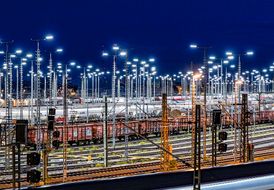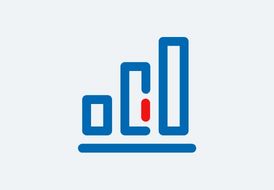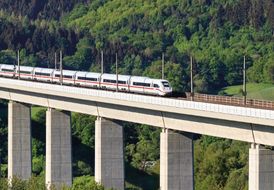Balance sheet
| BALANCE SHEET AS OF DEC 31 / € million | 2021 | 2020 | Change | 2019 | ||
absolute | % | |||||
Total assets | 71,843 | 65,435 | +6,408 | +9.8 | 65,828 | |
| ASSETS | ||||||
Non-current assets | 56,149 | 52,964 | +3,185 | +6.0 | 53,213 | |
Current assets | 15,694 | 12,471 | +3,223 | +25.8 | 12,615 | |
| EQUITY AND LIABILITIES | ||||||
Equity | 10,621 | 7,270 | +3,351 | +46.1 | 14,927 | |
Non-current liabilities | 39,631 | 37,686 | +1,945 | +5.2 | 32,820 | |
Current liabilities | 21,591 | 20,479 | +1,112 | +5.4 | 18,081 | |
In 2021, there were no material changes to the International Financial Reporting Standards (IFRS) regulations for DB Group’s consolidation and accounting principles that would result in any changes to the consolidated financial statements.
Total assets were significantly above the level at the end of the previous year:
- Non-current assets increased significantly, driven primarily by higher property, plant and equipment (€ +2,396 million). This was due to a persistently high level of net capital expenditures, particularly in the Integrated Rail System. The increase in receivables and other assets (€ +301 million) also had a supporting effect, due in part to the increase in receivables from transport concessions per IFRIC 12 at DB Regional, as well as derivative financial instruments in connection with hedging transactions for foreign currencies and energy (€ +205 million).
- Current assets increased somewhat more sharply. In particular, higher trade receivables (€ +1,627 million) mainly resulting from the positive business development at DB Schenker, as well as an increase in cash and cash equivalents (€ +1,180 million) and inventories (€ +218 million), mainly at DB Regional, were critical here.
On the assets side, this resulted in a slight structural shift in favor of current assets.
On the equity and liabilities side, equity increased significantly as a result of the Federal Government’s equity measures in connection with the Climate Action Program (€ +2,125 million) and the partial offsetting of losses resulting from Covid-19 (€ +550 million). The increase from the changes recorded in the reserves in connection with the revaluation of pensions (€ +1,431 million) also increased equity. The net loss for the year (€ –946 million) had a counterbalancing effect.
The more significant increase in equity in comparison to total assets led to an improvement in the equity ratio.
- Non-current liabilities also increased. In essence, this development was characterized by:
- higher non-current financial debt (€ +3,252 million) and
- an increase in other long-term reserves (€ +587 million) primarily associated with the revaluation of remedial action obligations (ecological burdens).
- This was counteracted by a decline in pension obligations (€ –1,486 million), mainly as a result of an increased interest rate following the revaluation, and
- lower other liabilities (€ –393 million).
- Current liabilities also increased. In essence, this development was characterized by:
- higher trade liabilities (€ +1,785 million) mainly at DBSchenker as a result of the positive business development,
- increased other provisions (€ +868 million), mainly due to allocations for revenue discounts at DB Regional, a possible repayment of infrastructure fees, and
- the increase in other liabilities (€ +575 million), due in part to the redemption of defined benefit pension obligations at DB Schenker in Sweden and an increase in customs liabilities at DB Schenker.
- In contrast, current financial debt fell significantly (€ –2,090 million). The main driver was the decline in bank loans due in the short term (€ –1,585 million) and bonds (€ –234 million) as well as the redemption of the last outstanding EUROFIMA loan (€ –200 million).
In terms of the structure of the equity and liabilities side, the increase in equity resulted in a shift that reduced the share of non-current and current liabilities.



